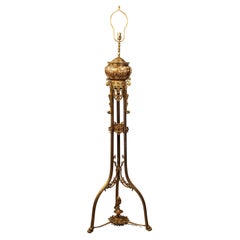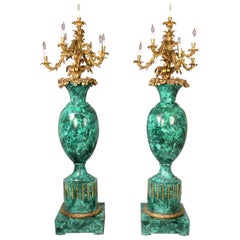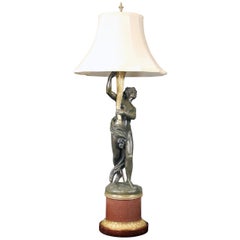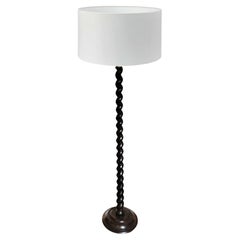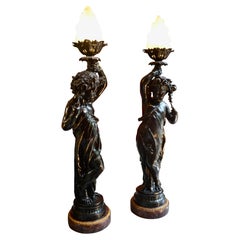Charles Cheriff Galleries Floor Lamps
to
3
3
Height
to
Width
to
2
1
2
1
1
3
3
2
2
1
2
2
1
1
1
3
3
3
1
Late 19th Century Gilt Bronze and Japanese Satsuma Porcelain Floor Lamp
By Satsuma
Located in Long Island City, NY
Late 19th Century Gilt Bronze and Japanese Satsuma Porcelain Floor Lamp
The round lamp with painted scenes of men, women and children in landscape scenes and at leisure...
Category
Antique Late 19th Century Japanese Belle Époque Floor Lamps
Materials
Bronze, Ormolu
Rare and Palatial Pair of Gilt Bronze and Malachite Seven Light Torcheres
Located in Long Island City, NY
A Rare and Palatial Pair of Mid 20th Century Gilt Bronze and Malachite Six Light Torcheres
The body of baluster form above a gilt bronze mounted circular and square base, the neck mounted with flowers and foliage leading up to seven tiered bronze acanthus arms.
Malachite is a semi-precious stone and also a valuable copper ore, hydrous copper carbonate. It is a beautiful green earth stone with irregular black banding. It is easily recognized by its color, green streak, and silky or velvety luster. It was used to make beautiful jewelry and to adorn only the finest pieces of furniture. In the 18th and 19th centuries malachite was popular with Russian Czars...
Category
Mid-20th Century French Belle Époque Floor Lamps
Materials
Malachite, Bronze, Ormolu
Late 19th Century Two-Tone Bronze Lamp after Clodion
By Claude Michel Clodion
Located in Long Island City, NY
A late 19th century two-tone bronze lamp
After Clodion
Cast as a female figure from a bacchanale upholding a cornucopia lamp, on a bronze-mounted...
Category
Antique Late 19th Century French Belle Époque Table Lamps
Materials
Marble, Bronze
Related Items
Floor Lamp Wood Barley Twist Column, RE 19th Century, Arts and Crafts Spain
Located in Mombuey, Zamora
19th Century or early 20th century
Floor lamp in the shape of a wooden solomon column.
* The measurement is of the wood, the lampshade is not included in the measurements or in the...
Category
Antique 19th Century Spanish Victorian Floor Lamps
Materials
Wood
H 59.06 in W 15.75 in D 15.75 in
Matching Pair of Figural Patinated Bronze Flame Torcheres after Clodion
By Claude Michel Clodion
Located in Vancouver, British Columbia
A beautifully cast matching pair of patinated bronze figural torcheres in the manner of Clodion modeled as classically draped young girls with garlands of flowers in their hair and h...
Category
Antique Late 19th Century French Napoleon III Floor Lamps
Materials
Bronze
19th Century Antique Japanese Meiji Bronze Floor Lamp
Located in Point Richmond, CA
19th century antique Japanese Meiji bronze floor lamp.
This finely cast, well composed, pedestal lamp depicts mythical creatures on the base, cranes in high relief on the stem are...
Category
Antique Late 19th Century Japanese Meiji Floor Lamps
Materials
Bronze
Pair of Palatial Italian 18thC 5-Light Rococo Giltwood Cherub Torcheres
Located in Vancouver, British Columbia
This pair of magnificent torcheres are of the finest quality carved wood, gilding and faux marble painting. Each are comprised of a giltwood cherub or putto figure sitting on faux m...
Category
Antique Late 18th Century Italian Rococo Floor Lamps
Materials
Giltwood
Very Important Satsuma Porcelain Lamp
By Satsuma
Located in Saint-Ouen, FR
Very Important Satsuma Porcelain lamp, mounted in Gilt Bronze and silk shade (very damaged, but historical), 19th century, Napoleon III period, Great de...
Category
Antique 19th Century Japanese Table Lamps
Materials
Porcelain
Bronze Mid Century Floor Lamp
By Hansen
Located in San Francisco, CA
Sculptural Patinated Bronze Square Floor Lamp sitting on a rosewood plinth base by Lawerence & Scott. This iconic design was featured in several of Ma...
Category
Mid-20th Century American Mid-Century Modern Floor Lamps
Materials
Bronze
Pair 19th Century Japanese Imari Porcelain & Gilt-Bronze Torchere Candelabra
By Imari Porcelain
Located in Los Angeles, CA
A fine Pair of 19th century Japanese Imari Porcelain and French Gilt-Bronze Mounted Thirteen-Light Celadon Torchere Candelabra. The bottle-shaped Japonisme vases with a Royal red background, decorated with parcel-gilt and black soaring eagles in the hunt within a forestall scene. Each Vase fitted and surmounted with a French 19th century Louis XV Style 13-Light scrolled candelabrum and all raised on a circular pierced gilt-bronze plinth. circa: 1880.
Imari Porcelain (????) is the name for Japanese porcelain wares made in the town of Arita, in the former Hizen Province, northwestern Kyushu. They were exported to Europe extensively from the port of Imari, Saga, between the second half of the 17th century and the first half of the 18th century. The Japanese as well as Europeans called them Imari. In Japanese, these porcelains are also known as Arita-yaki (???). Imari or Arita porcelain has been continously produced up through the present day.
Characteristics
Though there are many types of Imari, Westerners' conception of Imari in the popular sense is associated only with a type of Imari produced and exported in large quantity in mid-17th century. This type is called Kinrande. Kinrande Imari is colored porcelain with cobalt blue underglaze and red and gold overglaze. The color combination was not seen in China at that time. Traditional Ming dynasty color porcelain used dominantly red and green, probably due to scarcity of gold in China, whereas gold was abundant in Japan in those days. The subject matter of Imari is diverse, ranging from foliage and flowers to people, scenery and abstractions. Some Imari design structures such as kraak style were adopted from China, but most designs were uniquely Japanese owing to the rich Japanese tradition of paintings and costume design. The porcelain has a gritty texture on the bases, where it is not covered by glaze. There is also blue and white Imari. Kakiemon style Imari is another type of Imari, but it tends to be categorized separately in Europe.
History
"Imari" was simply the trans-shipment port for Arita wares. It was the kilns at Arita which formed the heart of the Japanese porcelain industry.
Arita's kilns were set up in the 17th century, when kaolin was discovered in 1616 by the immigrant Korean potter, Yi Sam-pyeong (1579–1655). (He may also be known by the name, "Kanage Sambei".) Yi Sam-Pyeong, along with his extended family of 180 persons, left Korea on the offer of a privileged position in Japan. This decision was made after the occurrence of certain Japanese invasions of Korea. After Yi Sam-Pyeong's discovery, his kilns began to produce revised Korean-style blue and white porcelains, known as "Shoki-Imari".
In the mid-17th century there were also a lot of Chinese refugees in Northern Kyushu due to the turmoil on Chinese continent, and it is said one of them brought coloring technique to Arita. Thus Shoki-Imari developed into Ko-KutaniImari. Ko-Kutani was produced around 1650 for both export and domestic market. Blue and white porcelain continued to be produced and they are called Ai-Kutani. Ko-Kutani Imari for the export market usually adopted Chinese design structure such as kraak style, whereas Ai-Kutani for the domestic market were highly unique in design and are accordingly valued very much among collectors.
Ko-Kutani style evolved into Kakiemon style Imari, which was produced for about 50 years around 1700. Imari achieved its technical and aesthetic peak in Kakiemon style, and it dominated European market. Blue and white Kakiemon is called Ai-Kakiemon. Kakiemon style transformed into Kinrande in the 18th century. Kinrande used blue underglaze and red and gold overglaze, and later some other colors.
Imari began to be exported to Europe because the Chinese kilns at Ching-te-Chen were damaged in the political chaos and the new Qing dynasty government stopped trade in 1656–1684. Exports to Europe were made through the Dutch East India Company, but the designation "Imari Porcelain" in Europe connotes Arita wares of mostly Kinrande Imari.
Export of Imari to Europe stopped in mid-18th century when China began export to Europe again, since Imari was not able to compete against China due to high labor cost. By that time, however, both Imari and Kakiemon style were already so popular among Europeans, Chinese export porcelain copied both Imari and Kakiemon style, which is called Chinese Imari. At the same time, European kilns, such as Meisen also tried to copy Imari and Kakiemon.
Export of Imari surged again in late 19th century (Meiji era) when Japonism flourished in Europe. Thus in western world today, two kinds of Imari can...
Category
Antique 19th Century Japanese Japonisme Floor Lamps
Materials
Bronze, Ormolu
Pair 19th Century Japanese Porcelain and Gilt Bronze Mounted Torchere Floor Lamp
By Imari Porcelain
Located in Los Angeles, CA
A fine pair of 19th century Japanese porcelain and French gilt bronze mounted thirteen-light celadon torchiere, floor lamp candelabra. Wired for ...
Category
Antique 19th Century Japanese Rococo Floor Lamps
Materials
Bronze
Pair of Gilt Bronze Standing Floor Lamps
Located in London, GB
Each floor lamp in this pair is constructed from gilt bronze and designed in a neoclassical manner to imitate the appearance of a Corinthian column. Each lamp is formed from a fluted...
Category
Early 20th Century French Neoclassical Floor Lamps
Materials
Ormolu, Bronze
Pair of Monumental French Antique Marble and Bronze Candelabra Torcheres
Located in London, GB
This pair of fine candelabra torcheres take form on a monumental scale, each of them standing almost two and a half metres tall. The casting is superior in its quality and could be attributed to one of the 19th century masters, such as Deniere or Barbedienne. Each torchere is formed of a fluted veined marble column set...
Category
Antique Late 19th Century French Neoclassical Torchères
Materials
Marble, Ormolu, Bronze
H 95.67 in W 22.05 in D 17.72 in
An Italian 19th Century Patinated Bronze Torchere, After Niccolò Roccatagliata
By Niccolo Roccatagliata
Located in Los Angeles, CA
A Large and Impressive Italian 19th Century Patinated Bronze Figural Torchere, after a model by Niccolò Roccatagliata (Genoa 1593 - Venice 1636). The triangular foot base with projecting putti supporting the stem and oval reserves within cartouche motifs, one containing the initials "S.D" with an olive tree in-between and a bull-head below. The stem knot with figures of winged caryatids and festoons and upper part with cherub heads, acanthus leaves and egg and bead patterns and topped with a later white glass globe. The decorative system refers to the documented artistic production of the Venetian workshop of Niccolò Roccatagliata and takes inspirational model from the base of the Renaissance bronze of the Scuola Grande di San Teodoro in Venice, a work signed by Andrea del Bartolomeo di Alessandri known as Brescianino. Electrified. Circa: Venice, 1850-1880.
RELATED LITERATURE
L. Planiscig, Venezianische Bildhauer der Renaissance, Vienna, 1921, figs. 661-664; C. Avery, 'Andrea del Bartolomeo di Alessandri detto il Bresciano" lavator di gettar di Bronzo": candelabri, satiri e battenti', M. Ceriana and V. Avery (eds.), L'Industria artistica del Bronzo del Rinascimento a venezia e nell'Italia settentrionale, Venice, 2008, pp. 233-252.
Similar models of this torchere were part of the interior decor collection at the Vanderbilt Mansion in New York (see black and white photo). The Cornelius Vanderbilt II House was a large mansion built in 1883 at 1 West 57th Street in Manhattan, New York City. It occupied the frontage along the west side of Fifth Avenue from West 57th Street up to West 58th Street at Grand Army...
Category
Antique 19th Century Italian Baroque Floor Lamps
Materials
Bronze
H 66.5 in W 19.25 in D 18 in
Large 19th Century Pair of Bronze Figural Torcheres
By A. Toussaint - G. Chaudoir, Ferdinand Barbedienne
Located in London, GB
A pair of Figural Porte-Lumières, cast by Barbedienne from the celebrated Armand Toussaint Models
Constructed in bronze, and having a patinated natural, and a highlighted gilt patin...
Category
Antique Mid-19th Century French Romantic Floor Lamps
Materials
Bronze
